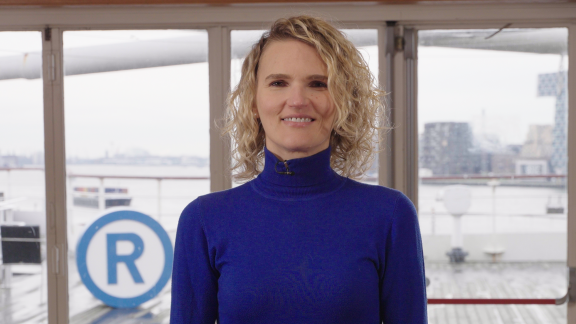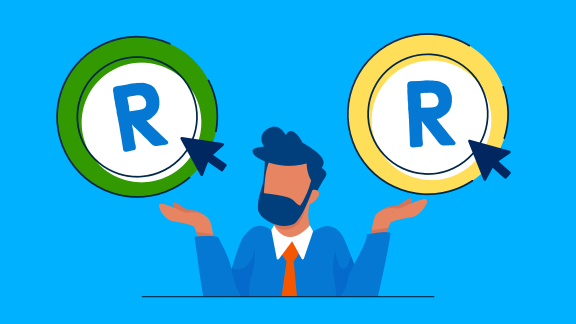Doing business is about investing – in your company, your products and services and in your brand. That’s because the name of your company or the logo on your products is worth money. By registering your trademark, you get the maximum out of your investments, and you can prevent others from misusing your brand (name) or counterfeiting your products.
On this page you can read all about trademarks:
1. The benefits of registering your trademark
You only actually own your name or logo if you have registered your trademark. Only then do you have a monopoly on your brand. What you do with your trademark is up to you. You can sell it, for instance, or you can license it. You can also take action against new trademarks that look similar to yours.

In this chapter you can read about:
Take the right steps to protect your idea
Do you have a good idea? Have you got a concept, a new product or something else you would like to earn money with? What do you have to do to prevent others walking off with your idea? How can you protect your idea?
Do business smarter using intellectual property
Receive our newsletter 4x per year with tips and tricks telling you how others do business smarter by using their intellectual property.
7 reasons to register your trademark
Did you know that you only actually own your trademark if you have registered your name or logo? That’s completely different to registering in the Trade Register! Fortunately, the costs for registering your trademark are reasonable: you can register from € 244, for 10 years. After that, you can renew (extend) your trademark, but you can also decide to sell it, for example. Moreover, registering your trademark means you are in a stronger legal position if someone counterfeits your products or misuses your logo.
We’ve set them out for you here: the 7 reasons to register your trademark
A trade name is not the same as a trademark
There is an important difference between a trade name and a brand name. Actively using a trade name gives you automatic protection, but only in the region where your business is active. Beyond that region, it is possible for others to go ahead and use your name. If you want to have the exclusive right to your name (in the whole of the Netherlands, Belgium and Luxembourg), you must apply to register your trademark.
In this article we explain the difference between trade name and brand name.
A trademark gives you the monopoly on your name or logo
If you register your trade name or product name as an official trademark, you gain the monopoly on it. It means that only you may use your brand (name) for the products and services under which you registered the trademark. You can also take action against any new similar trade names, trademarks and, in some cases, even domain names.
Read more about the monopoly on the name of your company, service or product
Trademark = intellectual property
A trademark is an intellectual property right. Intellectual property (often abbreviated to IP) is the collective term for rights relating to concrete ideas and creative concepts. These are, for example, trademark right for names and logos, design right for designs or patent right for technical innovations.
Discover the added value of intellectual property for your company
2. What do you have to consider when registering a trademark?
Registering your trademark costs money. Your name or logo must also meet a number of conditions for trademark registration, so make sure you prepare your registration properly. By doing so, you will also avoid other brands wanting to take action against your registration. You can register your trademark yourself online or you can ask a specialist (representative) to do it for you.

In this chapter you can read about:
Starting with trademark registration
Is your brand (name) important for the success of your business? If so, consider registering your trademark. Good preparation helps! Using the 4 steps for trademark registration makes the process easier.
Open an account
Are you about to register a trademark? Then you will need a My BOIP account. Open your account now and familiarise yourself with the registration procedure. It will help you to prepare more effectively.
Is my trademark still available?
It may be that the name or logo you came up with already exists AND is already registered as a trademark. However, that does not have to be a problem. There can be different 'Ajax' trademarks: for instance, for a football club, a cleaning product and fire extinguishers. The first step in registering your trademark is looking at whether your trademark (or something similar to it) already exists for the products and services you want to register it for. How you find this out, and what you have to look out for, you can discover in our 4 steps to trademark registration.
Find out whether your brand (name) already exists (Step 1)
Are you an entrepreneur in the Netherlands?
If so, you can use the Name checker to search. This lets you check with a single search request whether your name is already registered in the Chamber of Commerce Business Register and/or the BOIP Trademarks Register. Search with the Name checker
What does it cost to register a trademark?
Applying to register your trademark costs money but is not expensive. The basic fee to register a trademark for the Benelux (Belgium, the Netherlands and Luxembourg) is € 244 for 10 years. Your trademark is then registered for 1 category of products and services (also referred to as ‘class’).
For a 2nd category you pay € 27, and from the 3rd category you pay € 81 for each extra class. A higher fee is applied from the 3rd category to prevent trademarks being recorded for numerous categories unnecessarily.
All the prices for trademark registration are set out on our fees page
Trademark registration procedure: steps and duration
The procedure for applying for and registering your trademark takes approximately 3 months. BOIP verifies whether your application meets the formal requirements. After that, the substance of the application is verified to ensure the trademark complies with the statutory rules.
If this is in order, and there is no opposition, after 3 months your application is officially registered in the BOIP Trademarks Register. You also have the option of registering your trademark faster by way of an accelerated registration.
Read more about the procedure from applying for to registering a trademark
Avoid trademark refusal
Your application to register your trademark must comply with a number of statutory rules, otherwise we must refuse it. If that happens you will have no trademark protection. Moreover, the costs of your application will not be refunded. Here’s how you can avoid trademark refusal:
-
Your trademark must not be descriptive. By this we mean that your trademark – in its words and images – cannot be a general description of products or services. For example, a bicycle mechanic cannot register the word ‘bicycle’ as a trademark.
-
Your trademark must be distinctive. This means that the average consumer must be able to recognise your trademark as one that originates from a particular company: a simple image of a bottle for a wine merchant has little distinctive character for example.
Check the rules and examples relating to trademark acceptance and refusal
Do you want to register the name or the logo of your business?
When you register your trademark you can choose from different types of trademarks. For instance, you can choose the name of your company or product, the logo or both. How do you know what to choose? Check the overview with all the types of trademarks.
Choosing products and services when registering your trademark
You register a trademark for specific products and services. Your brand is only protected for the products and services you select. It means you must choose carefully, and you must think about what you want to do with your trademark in the future. A standard list of products and services is available to help you choose what you are going to use your trademark for.
You will find all the information about choosing the products and services in step 3
Trademark registration: do I register myself or do I outsource?
You can register your trademark yourself online in My BOIP. We will assess whether your application meets all the formal requirements. If that is not the case, you run the risk of your application being refused. You must also consider in advance which products and services you are registering your trademark for and check whether the trademark (or something similar to it) already exists. If you find that difficult, outsource then to a trademark specialist.
3. Make the most of your trademark
Registering your trademark protects your brand as well as ensuring added value. For example, you can use the ® symbol. That stands for professionalism and reliability and, if you invest wisely in your trademark, your trademark delivers more over time. You will have to renew (extend) your registration in time and, above all, don't forget to monitor your trademark so that you can take action against any infringement in good time.

In this chapter you can read about:
Monitoring your trademark
After registering your trademark, it's time for the next step. Of course, you don’t want anyone to use your trademark without permission or to apply to register a trademark that’s similar to yours. You can keep an eye on new trademark registrations with BOIP Trademark Alert. Try it out now for 3 months free of charge.
Stay tuned!
You’re busy taking care of your business. There’s not much time left to go searching for information about intellectual property. So, register for our newsletter! By registering for the newsletter, you will receive useful tips and tricks in your mailbox 4x per year.
Making use of the ® symbol
Would you like to show that your trademark has been officially registered? Place the ® symbol then – which stands for ‘registered trademark’ – against your brand (name). It signals credibility and can be the deciding factor that persuades customers to buy your product rather than that of your competitor. Talking about competitors, using the ® symbol means they can see directly that you are in a strong competitive position.
Restyling your trademark? Here’s what you can do
After a few years, it’s possible that your brand will be ready for a make-over. Keep an eye then on whether you still have trademark protection. If the restyled trademark differs too much from the original registered trademark, your brand is no longer protected. Is the appearance of your registered figurative mark changing, or is the name of your brand changing? If so, then there is only one thing to do: you must renew your trademark registration.
Restyling your trademark? Check your protection!
Are you offering new products and services with your trademark?
With your trademark registration, your brand is protected for the products and services you have selected. You do have to keep an eye on it though. This is because your protection does not automatically cover any new products and services you may offer under your brand.
Maintaining your trademark and using it!
Your trademark registration needs to be maintained. You must also actually use your trademark within 5 years – and for all of the products and services you applied for when registering it. If you fail to do so, others can oppose your trademark for those products and services for which the trademark is not being used.
Read article: Have you registered your trademark? Use it or lose it
You will find all the information related to maintaining your trademark on our page ‘Monitor, maintain and renew’
Trademark infringement? Here’s how you deal with it
You don’t have to call a lawyer immediately when you discover that someone is using your trademark without your permission, or when someone registers a trademark that is very similar to yours. It is often more advisable to contact the other party first. Being able to settle things amicably together means you will not have to start expensive legal proceedings. The same is true the other way around: you would probably prefer to receive a telephone call rather than a letter from a lawyer if someone believes you are infringing on them.
Someone is using your trademark and you want to do something about it
Monitoring your trademark
Your trademark registration makes it possible for you to take action against competitors who copy your trademark. You have to keep a look out yourself for anyone using your trademark without your permission, or for any other trademark that is similar to yours. There are different ways to do that monitoring: one is with BOIP Trademark Alert, for example.
It’s easy and reliable: a subscription to BOIP Trademark Alert (now with 3 months free of charge!)
Almost 10 years with a trademark? Here are your options
You can protect your trademark forever, in principle. The only thing you have to do is renew your trademark registration on time every 10 years. If there’s been no change to your logo and your business still offers the same products and services, then you have nothing further to do. If something has changed since you registered, then you must first check whether your trademark still ‘covers’ your current situation. These are the 4 options open to you:
- renew without any changes;
- let your registration expire completely;
- apply for a new trademark;
-
restrict your current trademark.
This is what you can do if your trademark registration is about to expire: all the options are set out for you here









